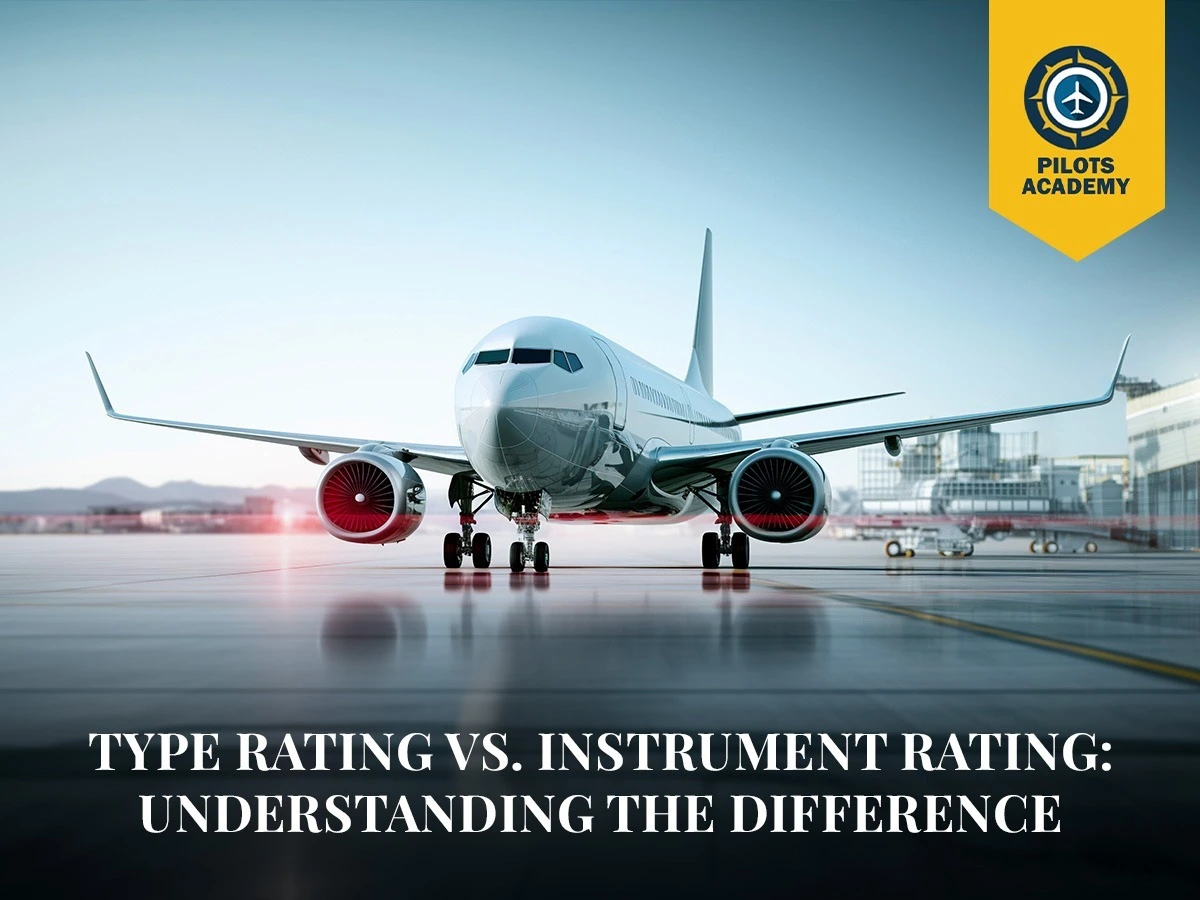Picture yourself in the cockpit of a commercial airplane, every switch and gauge under your control, the runway ahead, and the sky waiting to be conquered. For aspiring pilots, reaching this level goes beyond just earning a Commercial Pilot License (CPL).
Two key certifications—type rating and instrument rating—often make the difference between being a pilot and being an airline-ready professional.
Many students ask: “Which one should I pursue first? Do I need both? Can I fly without them?” Let’s break it down step by step.
What Is Type Rating?
A type rating is a specialised certification that allows a pilot to operate a specific model of aircraft. Unlike a general CPL, which lets you fly smaller or less complex aircraft, type ratings are mandatory for large commercial jets like Boeing and Airbus planes.
Why Type Rating Matters?
- Aircraft-Specific Training: Each aircraft has unique systems, engines, and avionics. A type rating ensures you are fully trained to handle these complexities.
- Career Requirement: Airlines require pilots to hold a type rating for the aircraft they will operate. Without it, even a fully licensed pilot cannot command certain commercial planes.
- Professional Credibility: Completing a type rating course demonstrates your readiness for airline operations.
Components of a Type Rating Course
A type rating course usually includes:
- Ground School: In-depth classroom sessions covering aircraft systems, avionics, and operating procedures.
- Simulator Training: Practice takeoffs, landings, and emergency scenarios in a realistic flight simulator.
- Flight Training: Hands-on flight hours with instructor supervision to consolidate learning.
- Assessments: Written and practical exams to certify your competence.
By the end of the type rating course, you are legally qualified to operate that specific aircraft commercially.
What Is an Instrument Rating?
An instrument rating (IR) allows a pilot to navigate and fly safely without relying on visual cues. This skill is essential for poor weather, night flights, and low-visibility conditions.
Unlike type ratings, an instrument rating is aircraft-independent. It equips you with skills applicable to multiple planes and enhances your overall safety and employability.
Why Instrument Rating Is Crucial?
- Enhanced Safety: You can handle low-visibility situations confidently.
- Career Advantage: Airlines often require IR for commercial operations.
- Operational Flexibility: IR-trained pilots can fly more routes and aircraft types.
Key Differences Between Type Rating and Instrument Rating
| Feature | Type Rating | Instrument Rating |
| Purpose | Aircraft-specific certification | Fly safely in poor visibility |
| Applicability | Required for complex aircraft | Aircraft-independent |
| Training | Ground + simulator + flight hours | Simulator + navigation training |
| Career Impact | Essential for airline jets | Enhances versatility and safety |
| Licensing | Aircraft-specific | Adds to CPL license |
Understanding these differences is essential when planning your pilot training path. Many students think that holding a CPL is enough, but airlines value pilots with both type rating and instrument rating.
Why Both Certifications Matter?
While a CPL allows you to fly, combining a type rating with an instrument rating gives you:
- Broader Career Opportunities: Airlines prefer pilots who are type-rated and IR-qualified.
- Higher Safety Standards: Be prepared for challenging weather and complex aircraft operations.
- Global Mobility: Both certifications increase employability internationally.
- Confidence in Flight: You can handle emergencies and difficult conditions with ease.
For aspiring airline captains, the typical sequence is:
CPL →Instrument Rating (IR)→Type Rating Course
Choosing the Right Type Rating Course
Selecting the right academy for your type rating course is critical. Consider:
- Experienced Instructors: Learn from pilots with real-world airline experience.
- Modern Fleet & Simulators: Gain hands-on training in advanced aircraft and simulators.
- DGCA/FAA-Compliant Curriculum: Ensure your training meets aviation authority standards.
- Career Guidance: Support for airline placement and international opportunities.
- Flexible Scheduling: Courses that adapt to your pace and career goals.
A high-quality type rating course not only prepares you for exams but also instils confidence for real-world airline operations.
Where Skills Meet the Skies
At Pilots Academy, we don’t just teach you to fly—we prepare you to command the skies with confidence. Imagine stepping into a simulator that mirrors real-world challenges, guided by instructors who’ve faced them all. Picture a structured type rating program where every lesson from ground school to actual flight hours builds your skills step by step.
Need guidance on landing your dream airline role? Our career support team is right there, helping you navigate applications and opportunities. By the time you graduate, you’re not just trained—you’re ready to handle commercial and international flights with assurance, competence, and the confidence every pilot dreams of.
Real-Life Example
Imagine a pilot with a CPL but no instrument rating. Flying in poor weather becomes risky. Conversely, a pilot with instrument rating but no type rating cannot operate a commercial jet. Only with both certifications is a pilot fully equipped to handle professional airline duties safely and efficiently.
To Sum Up
Both type rating and instrument rating are cornerstones of a successful aviation career. A type rating course unlocks opportunities to operate specific aircraft, while the instrument rating ensures you can navigate challenging conditions safely.
By pursuing training at Pilots Academy, students gain not only certifications but also expert guidance, practical experience, and career support, transforming aviation dreams into reality.
Whether your goal is to fly domestically or internationally, having both certifications positions you for success in a competitive industry.


